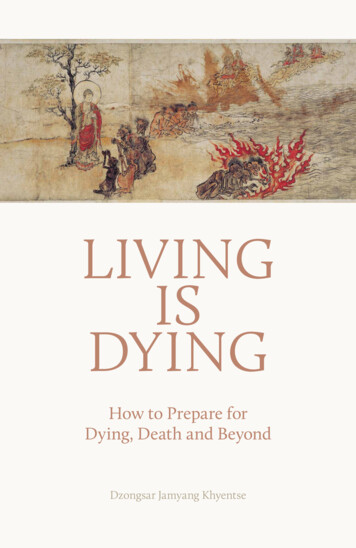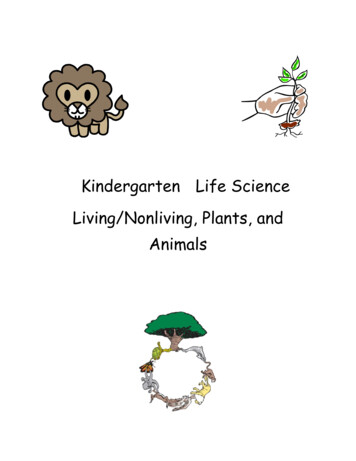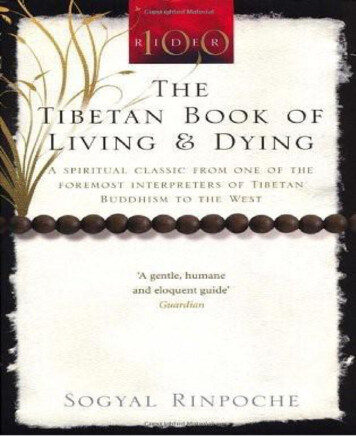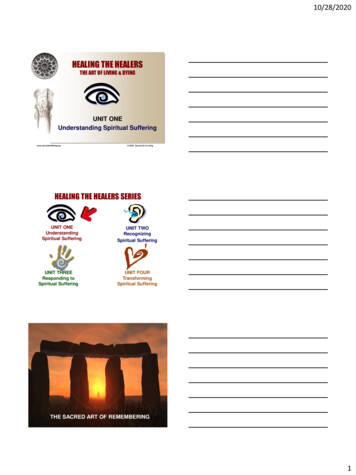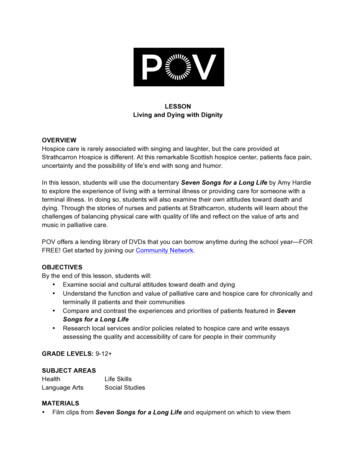
Transcription
LESSONLiving and Dying with DignityOVERVIEWHospice care is rarely associated with singing and laughter, but the care provided atStrathcarron Hospice is different. At this remarkable Scottish hospice center, patients face pain,uncertainty and the possibility of life’s end with song and humor.In this lesson, students will use the documentary Seven Songs for a Long Life by Amy Hardieto explore the experience of living with a terminal illness or providing care for someone with aterminal illness. In doing so, students will also examine their own attitudes toward death anddying. Through the stories of nurses and patients at Strathcarron, students will learn about thechallenges of balancing physical care with quality of life and reflect on the value of arts andmusic in palliative care.POV offers a lending library of DVDs that you can borrow anytime during the school year—FORFREE! Get started by joining our Community Network.OBJECTIVESBy the end of this lesson, students will: Examine social and cultural attitudes toward death and dying Understand the function and value of palliative care and hospice care for chronically andterminally ill patients and their communities Compare and contrast the experiences and priorities of patients featured in SevenSongs for a Long Life Research local services and/or policies related to hospice care and write essaysassessing the quality and accessibility of care for people in their communityGRADE LEVELS: 9-12 SUBJECT AREASHealthLanguage ArtsLife SkillsSocial StudiesMATERIALS Film clips from Seven Songs for a Long Life and equipment on which to view them
Official trailer for Seven Songs for a Long Life, http://www.pbs.org/pov/sevensongs/Computers with Internet accessStudent handoutso Student Handout A: Case Studieso Student Handout B: Group DiscussionTeacher handouto Teacher Handout: Curing and CaringESTIMATED TIME NEEDEDOne 50-minute class period plus homeworkFILM CLIPSFilm clips provided in this lesson are from Seven Songs for a Long LifeClip 1: “Trailer” (1:32 min.) www.pbs.org/pov/sevensongs/This is the official trailer for the film.Clip 2: “Get Back to the Actual Person” (1:19 min.)This clip starts at 6:03 min. with Mandy saying, “When I started nursing, I thought I wanted to dovery technical intensive care,” and ends at 7:22 min. with her asking, “How on earth do theyplan their future?”Clip 3: “‘Wouldn’t It Be Loverly’” (2:48 min.)This clip starts at 13:00 min. with Mandy saying, “I think the skills that we have developed hereas nurses are those of not wanting to fix everything,” and ends at 15:48 min. with Mandy singingwith another nurse as her voiceover says, “I think it’s one of the last things to deteriorate.”Clip 4: “Iain” (2:20 min.)This clip starts at 21:15 min. with Iain in bed and saying in voiceover, “It’s easy to give in to MS,”and ends at 23:35 min. with Moyra saying, “The bungalows are phenomenal prices, youknow?”Clip 5: “Julie” (1:31 min.)This clip starts at 27:08 min. with Julie and her daughter entering the church hall and hervoiceover saying, “You don’t have a crystal ball,” and ends at 28:39 min. with Julie saying,“Nobody likes to talk about death, but it’s just one of those things in life—you’ve got to.”Clip 6: “Alicia” (2:37 min.)This clip starts at 29:46 min. with Alicia watching the shopping network and ends at 32:21 min.with Alicia finishing her song by singing, “Sad am I, without thee.”Clip 7: “Nicola” (5:33 min.)This clip starts at 46:18 min. with Nicola writing in her notebook and saying in voiceover, “Thepain that I was in was horrendous. I really can’t remember,” and ends at 51:51 min. with Nicolaand Mandy finishing their song and the patients clapping.
VOCABULARYThe following are abbreviated versions of definitions from the Merriam-Webster Dictionaryonline: www.merriam-webster.com Art therapy: therapy based on engagement in artistic activities as a means of creativeexpression and symbolic communicationHospice: a facility or program designed to provide a caring environment for meeting thephysical and emotional needs of the terminally illMusic therapy: therapy based on engagement in musical activities: the therapeutic useof music that typically involves listening to music, singing, playing musical instruments orcomposing musicOccupational therapy: therapy based on engagement in meaningful activities of dailylife (as self-care skills, education work or social interaction) especially to enable orencourage participation in such activities despite impairments or limitations in physical ormental functioningPalliative care: medical and related care provided to a patient with a serious, lifethreatening or terminal illness that is not intended to provide curative treatment butrather to manage symptoms, relieve pain and discomfort, improve quality of life andmeet the emotional, social and spiritual needs of the patientPhysical therapy: the treatment of disease, injury or disability by physical andmechanical meansFACILITATOR NOTE:This lesson plan focuses on issues surrounding palliative care and social and cultural responsesto death and dying. Educators and facilitators are strongly encouraged to review all of thematerials and film clips to be sure the topic and lesson are appropriate for their curricula andstudents. At the teacher’s discretion, a preliminary discussion with the class may be required, asit may be advisable to identify students who might be personally and/or adversely affected bythis material. Teachers should also consult with school counselors, social workers and/oradministrators to provide students with support or the option of not participating in the lessonwhere appropriate. Some students may not be open to talking about death and/or may haverecently experienced the deaths of loved ones. Please be sensitive about their desire tocommunicate when ready.ACTIVITYStep 1: Talking About DeathIn this activity, students will examine their responses to death and dying and discuss some ofthe factors that shape attitudes toward this topic.Do Now Think-Pair-Share: Write the following quote by Jok Church (writer, educator, animator,cartoonist) on the board:Death is a part of life And you know, that part of life needs everything that the rest oflife does.
Have students rewrite the quote in their own words and share their responses with partners. Askfor volunteers to share their responses with the class and then hold a discussion.Discussion prompts: Do you agree with this quote? Why or why not? When do we typically encounter conversations about death and dying? In whatcontext does this topic come up? What are some factors that shape how we respond to the topic of death and dying?(Family, tradition, culture, movies, music, news, religion and so on.) What benefit, if any, is there in discussing death and dying?Explain to students that they are going to have a conversation about how we respond—personally and culturally—to the process of dying and how we care for people who are livingwith terminal illnesses.Have students complete the following sentence in writing. (Note: Students may share theirresponses now or keep them private until the end of the lesson, when they will refer to themagain as part of a journaling activity.)When we talk about death and dying, I feel ,because .Step 2: Understanding Hospice CareIn this activity, students will explore and discuss palliative and hospice care through theexperiences of nurses treating chronically and terminally ill patients at Strathcarron Hospice inScotland.Introduce the lesson plan vocabulary (palliative care, hospice, physical therapy, art therapy).Explain: Today, we will be watching clips from the film Seven Songs for a Long Life, whichfollows the stories of several hospice patients at Strathcarron Hospice in Scotland as theyconfront the challenges of living with terminal illness.Screen and discuss Clip 1, the official trailer for Seven Songs for a Long Life and Clip 2,featuring Strathcarron palliative care nurse Mandy explaining her personal experience as anend-of-life caregiver and the value of art and music therapy. Have students take notes whilewatching the clip with a focus on the following prompt: “What are the responsibilities of apalliative care nurse?”(Facilitator note: Explain that Clip 2 is short, so students will need to engage in proactiveviewing.)After screening Clip 2, review the students’ notes and discuss:
ooHow did Mandy’s attitude toward her roles and responsibilities change overtime?What did Mandy highlight as her most important responsibility?Explain: Palliative care professionals (doctors, nurses and other staff members) have to balancetwo very important priorities when working with patients: treating physical illness and caring forwellbeing. Sometimes what is good for the body can be hard on the patient and the patient’squality of life (for example: some treatments cause extreme pain and discomfort) and vice versa(for example: minimizing difficult treatments could limit opportunities for improvement). In eachcase, outcomes are uncertain, so no guarantees can be given. This situation requirescaregivers to work with the patients to make difficult decisions about the physical and emotionalcost and benefits of each treatment.Ask for volunteers to read the Teacher Handout: Curing and Caring to the class and discuss:o How does Mandy balance curing and caring?o Mandy says, “We can’t fix everything and what we have to learn to do is listen.And sometimes you have to sit on your hands because all you want to do is fixit, and you can’t fix it, you just listen. And listen properly.” What does shemean by this? Why does she stress the importance of listening “properly”?How does this relate to what we read about curing and caring?Screen Clip 3 and have the class record scenes and quotes that demonstrate Mandy and hercolleagues curing, caring and listening.After viewing the clip and before the class discussion, have students free-write for one minuteusing the following prompts and share their feedback with the class:Discussion prompts: What feelings did you have when the patients and nurses started singing? What wasyour first response? Why do you think we reacted the way we did to the patients and nurses singing? Why doyou think singing inspires so many emotional responses in us? How might thesecomplex reactions be beneficial for patients and caregivers in a hospice? What surprised you most in this clip? How does Mandy balance curing and caring in her work with patients? Can you give an example of Mandy “listening properly”? How does this strategy help to balance her responsibility to both cure and care forDorene? What personal reason does Mandy give for why she chose to incorporate music into herpatients’ therapy? What benefits do you think music can offer to people who are experiencing illness? Can you share an example from your own life of music or art helping you through adifficult time?
Step 3: Living and Dying with DignityIn this activity, students will compare and analyze the goals and priorities for end-of-life carethrough the case studies of patients featured in Seven Songs for a Long Life.Organize students into small groups. Assign each group a patient—Nicola, Iain, Julie, orAlicia—as a case study and have each group view their patient’s video clip.Distribute a copy of Student Handout A: Case Studies to each student and instruct the groups tocollaborate on completing the viewing and discussion worksheet. (Although the students willcollaborate on the handout, each should complete a worksheet for use later in this activity.)Facilitator note: If there are not enough computers available for each group to view its casestudy clip independently, play Clips 4 through 7 (12:01 min. total) for the class, then divide thestudents into their case study groups.When all the groups have completed their worksheets, reorganize the class into new groups offour or more students, so that each new group has at least one representative for each casestudy patient.Distribute one copy of Student Handout B: Group Discussion to each new group. Instruct thenew groups to review their case study worksheets with each other and share what they learnedfrom their patients’ stories. They should then use the prompts in Student Handout B to discussfurther the similarities and differences in their patients’ experiences.Facilitator note: To save class time, teachers can go straight from the case study groups to aclass discussion. Ask a representative from each case study group to share that group’sfindings with the class, followed by a class discussion using prompts from Student Handout B.Step 4: ReflectionConclude the lesson by asking students to write journal entries using one of the followingprompts (this can also be completed as a homework assignment): Revisit how you described your feelings about death and dying in step 1. In what way, ifany, has your response changed and why? If you were one of the patients (or caregivers) at Strathcarron, what would be your “songfor a long life”? Why would you choose this song? How do you think music and art helpto reinforce the rights and dignity of patients in hospice?Step 5: Hospice in My CommunityHave students research and report on palliative care services in their community, including thequantity and quality of options available; the resources and services provided; and the averagecost of care for inpatient services over the course of one year. Students should also: Identify opportunities for improvement Explain how they could personally contribute to improving care in their community
Conclude the assignment by having students draft descriptive essays detailing what they havelearned and how they can personally contribute to improving care in their community.EXTENSIONS/ADAPTATIONS1. The Rights of the DyingIn this activity, students will work together to draft a patients’ bill of rights for people living withterminal illnesses based on discussions from this lesson and supplemented with additionalresearch.Distribute sticky notes, a sheet of chart paper and markers to each group. Have the class reflecton the stories of the patients and nurses depicted in Seven Songs for a Long Life and givethem five minutes to brainstorm the rights they believe hospice patients and people living withterminal illnesses should have. Remind students that these rights have to balance patients’physical and emotional needs and should uphold and reinforce the patients’ dignity. Eachstudent should brainstorm her/his own ideas (one idea per sticky note).Have each group review and organize their members’ ideas by theme and use this brainstormto draft a bill of rights for end-of-life patients on the chart paper. (If time allows, students canalso research the legal rights of terminally ill patients as well as existing frameworks for hospicepatients and the terminally ill to refine their work.)Follow with a gallery walk and feedback session, and then refine the groups’ work into a singlecollective bill of rights for the class.2. Sharing Seven Songs for a Long LifeOrganize a visit to a local hospice and have students interview the patients. The studentsshould prepare questions in advance and include questions about the importance of music,visual arts, dance and so on in their subjects’ lives. The interviews can be documented throughwritten notes or audio/video recording. Have the students create multimedia oral histories abouttheir subjects that feature meaningful songs from the patients’ lives, and then have them returnto the hospice to present their projects to the patients.3. The Politics of Palliative CareHave students research local and national laws and policies related to end-of-life care, with afocus on the following questions: What public policies influence the quality of care? Are there national standards or do they vary from state to state? What influence do your local government and representatives have on the quality andoptions for care?Conclude the assignment by having students draft persuasive essays to a local communityleader or political representative. The essays should explain why hospice care is important forthe community and describe the end-of-life care that is available, the improvements that are
needed and the current barriers to quality care. Students should also explain how they canpersonally contribute to improving care in their community.4. On Death and Dying: The Stages of GriefMotivated by the lack of curriculum in medical schools on the subject of death and dying, Swissdoctor Elisabeth Kübler-Ross began to examine death and those faced with it at the Universityof Chicago medical school. Her research, which included patient interviews, became thefoundation for her 1969 book On Death and Dying. This book introduced the concept of the“stages of grief,” and although it has met with criticism and controversy since it was published, itremains highly influential in the field of palliative care. Have students research the history andimpact of On Death and Dying and the arguments for and against Kübler-Ross’ findings. Ifpossible (and appropriate), have each student interview a person who has experienced the lossof a loved one and compare that experience to Kübler-Ross’s findings. Have students concludethe project with a presentation incorporating their research and interviews.5. The Stem Cell DebateSeveral patients in Seven Songs for a Long Life speak about participating in stem celltreatments and trials for their terminal conditions. Is stem cell research the great hope for peoplewho suffer from debilitating diseases, or is it an unethical treatment of human life? Stem cellresearch is a controversial subject due in part to the debate over whether embryonic stem cellsshould be used.Have students facilitate a debate about stem cell research and the use of embryonic and adultstem cells to provide therapies for diseases and injuries.Create an anticipation guide with questions about the moral, ethical and political issues relatedto stem cell research, and then have students research the science and politics behind the useof stem cells in medical treatments.Give all students the opportunity to share their projects and opinions with the class or in smallgroups.6. The Debate Over the Right to DieDo people have a right to die? How does this right compare to a person’s right to free speech orother similar rights? Why are certain groups and individuals particularly opposed to euthanasia?How is this issue covered in news and entertainment media?Have your students research basic facts about euthanasia and current state and nationalpolicies regarding an individual’s right to die.Have them discuss and assess the precedents for a government’s right and ability to intervenein personal health decisions and the impact that legalizing euthanasia has had in states andcountries where that has been implemented.
Each student can complete the research by writing two persuasive essays, each taking anopposing position on the issue.RESOURCESThe FilmPOV: Seven Songs for a Long Lifewww.pbs.org/pov/sevensongs/The film’s official POV site includes a discussion guide with additional information, resourcesand activity ideas, a reading list of suggested books and more.Seven Songs for a Long Lifewww.sevensongsfilm.com/The film’s official website provides information on the film and filmmakers, as well assuggestions for using the film.POV: Media Literacy Questions for Analyzing POV cy.phpThis list of questions provides a useful starting point for leading rich discussions thatchallenge students to think critically about documentaries.POV: Seven Songs for a Long Life Discussion guideThe POV Seven Songs for a Long Life discussion guide includes information onStrathcarron Hospice and caring versus curing, as well as prompts for discussion, takingaction steps and resources.POV: Seven Songs for a Long Life Delve Deeper Reading nsongs-delve-deeper-reading-list.pdfThis list of fiction and nonfiction books provides a range of perspectives on the issues raisedby the film.Buy the Filmhttp://www.sevensongsfilm.com/eduPurchase Seven Songs for a Long Life for your classroom. The educational edition of thefilm includes: The feature version of Seven Songs for a Long Life Four interactive sessions with the characters in the film Education clips: 11 excerpts from the film that expand upon palliative care from patientand staff perspectivesAmerican Art Therapy Associationwww.arttherapy.org
This group provides resources for the advancement of art therapy as a mental health andhuman services tool.American Music Therapy Associationwww.musictherapy.orgThis group provides information and resources on the development of the therapeutic use ofmusic in rehabilitation, special education and community settings.End of Life: Helping with Comfort and d-of-life-helping-with-comfort-and-care.pdfThe National Institutes of Health publish this resource, which offers information and guidance forindividuals facing the end of life.Hospicewww.hospicenet.orgThis website serves as an information clearinghouse for patients and families coping withterminal illness.The National Institute on Agingwww.nia.nih.govThe website of this government organization, part of the National Institutes of Health, offersinformation on resources and services for older adults.STANDARDSCommon Core State Standards for English Language Arts & Literacy in History/SocialStudies, Science and Technical Subjects(http://www.corestandards.org/assets/CCSSI ELA%20Standards.pdf)CCSS.SL.9-10.1 Initiate and participate effectively in a range of collaborative discussions (oneon-one, in groups and teacher-led) with diverse partners on grades 9-10 topics, texts andissues, building on others’ ideas and expressing their own clearly and persuasively.CCSS.ELA-Literacy.SL.11-12.1 Initiate and participate effectively in a range of collaborativediscussions (one-on-one, in groups and teacher-led) with diverse partners on grades 11-12topics, texts and issues, building on others’ ideas and expressing their own clearly andpersuasively.CCSS.ELA-Literacy.SL.9-10.2 Integrate multiple sources of information presented in diversemedia or formats (e.g., visually, quantitatively, orally), evaluating the credibility and accuracy ofeach source.CCSS.ELA-Literacy.SL.11-12.2 Integrate multiple sources of information presented in diverseformats and media (e.g., visually, quantitatively, orally) in order to make informed decisions andsolve problems, evaluating the credibility and accuracy of each source and noting anydiscrepancies among the data.
CCSS.ELA-Literacy.SL.9-10.4 Present information, findings and supporting evidence clearly,concisely and logically such that listeners can follow the line of reasoning and the organization,development, substance and style are appropriate to purpose, audience and task.CCSS.ELA-Literacy.SL.11-12.4 Present information, findings and supporting evidence,conveying a clear and distinct perspective, such that listeners can follow the line of reasoning,alternative or opposing perspectives are addressed and the organization, development,substance and style are appropriate to purpose, audience and a range of formal and informaltasks.CCSS.ELA-Literacy.SL.9-10.5 Make strategic use of digital media (e.g., textual, graphical,audio, visual and interactive elements) in presentations to enhance understanding of findings,reasoning and evidence and to add interest.CCSS.ELA-Literacy.SL.11-12.5 Make strategic use of digital media (e.g., textual, graphical,audio, visual and interactive elements) in presentations to enhance understanding of findings,reasoning and evidence and to add interest.CCSS.ELA-Literacy.RH.9-10.4 Determine the meaning of words and phrases as they are usedin a text, including vocabulary describing political, social or economic aspects of history/socialscience.CCSS.ELA-Literacy.RH.11-12.4 Determine the meaning of words and phrases as they are usedin a text, including analyzing how an author uses and refines the meaning of a key term over thecourse of a text (e.g., how Madison defines faction in Federalist No. 10).CCSS.ELA-Literacy.RH.9-10.6 Compare the point of view of two or more authors for how theytreat the same or similar topics, including which details they include and emphasize in theirrespective accounts.CCSS.ELA-Literacy.RH.11-12.7 Integrate and evaluate multiple sources of informationpresented in diverse formats and media (e.g., visually, quantitatively, as well as in words) inorder to address a question or solve a problem.Content Knowledge: (http://www2.mcrel.org/compendium/) a compilation of content standardsand benchmarks for K-12 curriculum by McREL (Mid-continent Research for Education andLearning).Behavioral Studies, Standard 4: Understands conflict, cooperation and interdependenceamong individuals, groups and institutions.Health, Standard 3: Understands the relationship of family health to individual health.Health, Standard 4: Knows how to maintain mental and emotional health.ABOUT THE AUTHORAllison Milewski has developed media education resources for a range of award-winningfilmmakers and national media organizations, including PBS LearningMedia, IndependentTelevision Service (ITVS), Latino Public Broadcasting, HBO Documentaries and Tribeca FilmInstitute. She is also the founder of the international media education programPhotoForward.org.
SEVEN SONGS FOR A LONG LIFETeacher Handout: Curing and CaringCuring“The ‘medical model’ of dying says there comes a time when all possible treatments have beentried and there is nothing left to do that will prevent death. In this view, we must ‘give up’ fightingagainst death when we have no other choice.“When doctors, nurses and direct caregivers think this way, they might quit giving good care to adying person because they feel there is nothing more that can be done. They feel they have lostcontrol because they can’t ‘fix’ the problem, and may feel helpless and guilty. These feelingscan lead them to avoid the dying person. People at the end of life can sense this in theircaregivers, and they may fear being abandoned. This fear increases their loneliness anddiscomfort.”Caring“The ‘caring model’ of dying says the end of life is an important period of an individual’s life.During this final phase, curing the problem is no longer possible, and the focus shifts to caringfor the person. When caregivers think this way, they concentrate on the many things they cando to make a dying person comfortable, to improve the quality of the dying person’s life and toprovide opportunities for the person to meet his or her final life goals.“When caregivers focus on caring, they shift their energies from whether the person will die tohow they will die. Helping to relieve pain and other symptoms, giving emotional and spiritualsupport and providing family time are all things that caregivers can do to care for a dyingperson.”Excerpted from:HCPro. “End-of-Life Care.” www.hcpro.com/content/40619.pdf
SEVEN SONGS FOR A LONG LIFEStudent Handout A: Case StudiesSTUDENT’S NAMEInstructions: Watch the film clip(s) about your case study patient and collaborate withyour group members to complete the following worksheet. (Note: If you need more spaceyou may write your responses on the back of this page or on a separate sheet of paper.)CASE STUDY SUBJECT’S NAME:1. What physical problems is your patient experiencing? What is the patient not able to do nowthat they could do before the illness?2. What impact has the patient’s illness had on their relationships with family and friends?3. How has your patient’s illness affected their emotional wellbeing? What are your patient’sbiggest worries? Please give examples from the film.4. How does your patient feel about death and dying? Please give examples from the film.5. What activities, resources and support systems are available to the patient to help themcope with the emotional impact of their illness? List as many as you can.6. What role does music play in this patient’s care?7. Select a quote (1-3 sentences) from your patient’s film clip that best illustrates how they feelabout their experience. Write the quote below.
SEVEN SONGS FOR A LONG LIFEStudent Handout B: Group DiscussionInstructions: Watch the film clip(s) for your case study patient and collaborate with yourgroup members to respond to the following questions. (Note: If you need more spaceyou may write your responses on the back of this page or on a separate sheet of paper.)1. What are the most common emotional challenges that the patients are facing?2. What are some similarities in the coping strategies and support systems that the patientsare using?3.What common benefits do music and art provide for the patients?4. Merriam-Webster Dictionary defines dignity as “the quality or state of being worthy of honorand respect.” How does the palliative care at the hospice reinforce the dignity of the patientswho are being treated there? Give examples from the film for each patient to support yourresponse.
LESSON Living and Dying with Dignity OVERVIEW Hospice care is rarely associated with singing and laughter, but the care provided at Strathcarron Hospice is different. At this remarkable Scott

